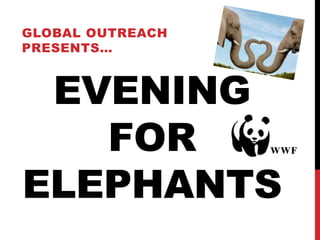
Evening for elephants
- 1. GLOBAL OUTREACH PRESENTS… EVENING FOR ELEPHANTS
- 2. STATUS • African Elephants are a symbolic creature of Africa. • Its population is steadily declining, as it has been internationally acknowledged as vulnerable. • There are only an estimated 470,000-690,000 African Elephants left in the world today (“African Elephants”). • Only 20% of the elephant population is under formal protection (“African Elephants”). • They are being forced out of their natural habitats in the savannas of Eastern and Southern Africa, and in the tropical rainforests of West and Central Africa (“African Elephants”). • Samuel Wassner, warned that African Elephants are steadily being pushed into extinction due to the ivory trade (Stiles). • They could be extinct by 2020 at the current rate (Stiles). • Populations that were thought to be increasing, have fallen again due to the growing ivory trade (Shoumatoff).
- 4. CAUSES • Many elephants are killed for bush meat. There is a lot of money to be made in the bush meat trade with elephants. • Meat prices range from 1-5 dollars per kilogram (Stiles). • Hunters sell all parts of the elephant. The entire elephant itself sells for almost 10,000 dollars (Stiles). • In some cases, bush meat may cost more than ivory (Stiles). • With an increasing number of changes in land-use, the growth of human population and extensive agriculture into rangelands and forests mean that large areas of land are now off limits for elephants (Fuashi). • In 1979, the elephants’ range was three million square miles. In 2007, it was just over one million square miles (Fuashi). • The decreased habitat makes elephants easier to hunt, and more likely to invade human territory, where they are killed (Fuashi). • Humans are introducing threats to the elephants with their land development. large and small farm estates, forest exploitation, hunting and poaching, road construction, settlement, and mining (Fuashi). • Commercial logging for instance, not only destroys elephant habitat, but it also creates access to elephant forests for poachers (Fuashi).
- 5. CAUSES • With increasingly high demands for ivory and an un- monitored domestic ivory market fueling the international trade, elephants have became an ideal target for poachers. • China’s price for ivory now sits at over $700 a pound, as it has brought new life to the illegal ivory trade (Shoumatoff). • It is difficult for the government to protect elephant herds. As such, the ivory trade is difficult to stop (Shoumatoff). • Despite its illegal status, ivory consumption has been increasing in both Asia and Africa over the last couple years (Furniss). • The growth of China’s economy has made private ivory enterprises possible (Furniss).
- 7. EFFECTS • With the constant migration of elephants as a result of human development,the elephants become unable to complete their ecological role (Chafota). • Slower nutrient cycling in habitats. This is detrimental for other species; namely herbivores, who rely on the elephants’ nutrient cycling (Chafota). • Up to 30 percent of tree species rely on elephants to help with dispersal and germination (Chafota). • With elephants being forced out of their habitats, they occasionally stumble into human settlements. This is detrimental to both the humans and the elephants. • Invading elephants damage crops, kill livestock and trample villages (African Elephants”). • Invading elephants are eventually killed, but not without trampling on a couple people (“African Elephants”).
- 8. EFFECTS • With fewer elephants in certain habitats, there has been an encroachment of forests and thickets which has resulted in a decline in population of other animals in the same area (Chafota). • Zebras, black rhinos and waterbucks (Chafota). • The poaching of elephants has had a detrimental effect on elephant behavior, genetic structure and health (Archie, Chiyo). • More rapid loss of genetic diversity. Stronger genetics die (Archie, Chiyo). • Reduced offspring survival and reproductive rates (Archie, Chiyo). • Loss of older, reproductively successful partners (Archie, Chiyo). • Loss of social relatives (Archie, Chiyo).
- 10. WORLD WILDLIFE FUND Who They Are • World’s leading conservation organization. • About 5 million members globally. • 85% of the proceeds goes directly towards animal conservation. What they’ll do • Equip and train law enforcement to effectively carry out anti-poaching laws. • Establish new protected areas within elephant ranges. • Help the government adopt elephant conservation strategies.
- 12. WORKS CITED "African Elephants." WWF. WWF. Web. 17 Oct 2012. <http://wwf.panda.org/what_we_do/endangered_species/elephants/african_elephants/>. Chafota, Jonas. "Effects of Changes in Elephant densities On the Environment and other species- How much do we know?." Agricultural & Resource Economics at UC Davis. WWF. Web. 1 Nov 2012. <http://agecon.ucdavis.edu/people/faculty/lovell-jarvis/docs/elephant/Chafota.pdf>. Fuashi, Nkwatoh Athanasius, and Victor Chik Fosah. "Forest/habitat fragmentation and human-elephant conflicts in the Takamanda-Mone landscape of the South West Region of Cameroon." Journal of Biology and Life Science 3.1 (2012): 266+. Academic OneFile. Web. 18 Oct. 2011 <http://go.galegroup.com/ps/i.do?id=GALE%7CA303895072&v=2.1&u=ko k12hs_d73&it=r&p=GPS&sw=w>. Furniss, Charlie. "On the Tusks of a Dilemma." Geographical Nov. 2006: 47+.General OneFile. Web. 15 Oct. 2012. <http://go.galegroup.com/ps/i.do?id=GALE%7CA156203892&v=2.1&u=ko_k12hs_d73&it=r&p=GPS&sw=w>. Lewis, Matthew. "African Elephant." World Wildlife. World Wildlife. Web. 18 Oct 2012. <http://worldwildlife.org/species/african-elephant>. Shoumatoff, Alex. "Agony and Ivory." Vanity Fair Aug. 2011: 120. Gale Power Search. Web. 15 Oct. 2012. <http://www.vanityfair.com/culture/features/2011/08/elephants-201108>. Stiles, Daniel. "Jumbo threat: elephants as bushmeat." Natural History Apr. 2012: 12+. Gale Power Search. Web. 16 Oct. 2012. <http://go.galegroup.com/ps/i.do?id=GALE%7CA292087096&v=2.1&u= ko_k12hs_d73&it=r&p=GPS&sw=w>.
